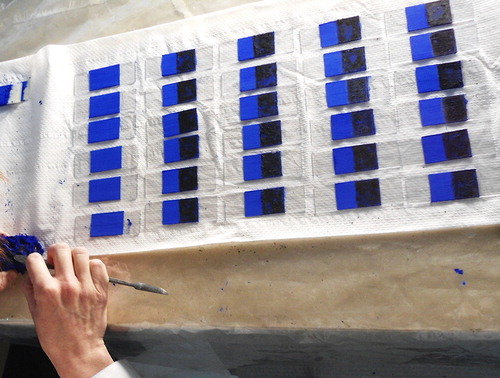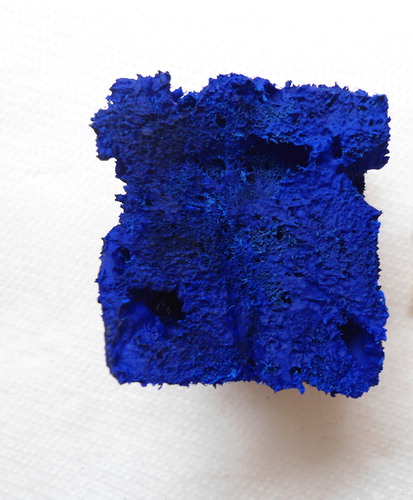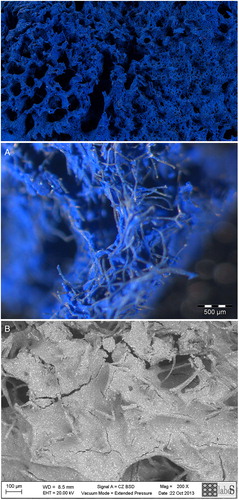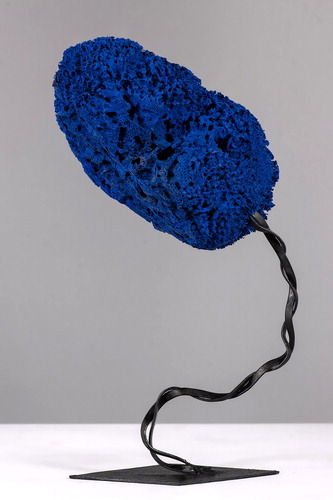Abstract
Yves Klein's Sculptures-Éponge are natural sea sponges soaked in International Klein Blue (IKB), assembled on metal pedestals. This work examines the constituent materials, the execution technique and the deterioration problems of the sculptures which are covered by a friable matt paint, in order to define the guidelines for treatment and collections care. For the experimental work, samples were prepared in the laboratory with the same materials and techniques used by the artist. In order to solve problems relating to removal of dust deposits, many aspects were considered in the evaluation process, such as the presence of an organic and porous support, not discussion in the existing literature, the poor cohesion of the surface and Klein's specific recommendations for handling his Monochromes only with gloves, and removing dust while avoiding any contact with the painted layers. Photo-ablation using laser radiation was identified as a possible solution. Three Nd:YAG lasers with different pulse durations (short free-running (SFR), long Q-switched (LQS), and Q-switched (QS)) operating at 1064 nm were tested on two kinds of support (samples of sponges saturated of IKB and glass slides painted with the same color) and on two different types of dirt (one only deposited and another adhered to the support). The interaction of laser radiation with the support and with the paint layers, and the effectiveness of cleaning operations, was monitored with a stereo microscope and a scanning electron microscope (SEM). It was possible to define a method which was then applied for the removal of particulate dirt from a blue sponge stored in the Museum of Modern Art, Turin, Italy.
Introduction
This work began due to our interest in a blue sponge, similar to the Sculptures-Éponge created by Yves Klein between 1957 and 1962, in the Museum of Modern Art, Turin, Italy. The blue sponge was declared false by Klein's widow and was together with many other Monochromes, the subject of a legal dispute at the time of the Klein exhibition at the museum in 1970. For this reason, the sculpture cannot be displayed ().
Figure 1. The blue sponge stored at Turin's Museum of Modern Art. The sponge is 22 cm in height and 15 cm in width; the total height of the object, from the base, is 37 cm (these are maximum dimensions).
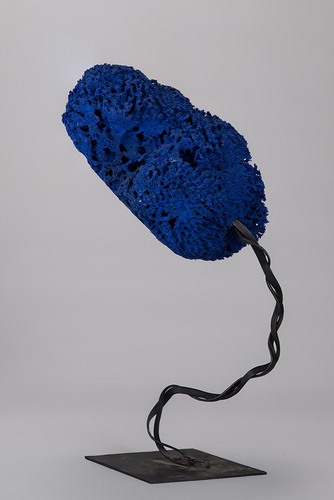
A study of the documents in the warehouses of the Court in Turin, Italy, produced by the lawyers involved, provided useful information which permits a comparison, both stylistically and technically, between the sponge stored in the museum and the accepted Sculptures-Éponge. This makes it an interesting case study that can be interpreted as a naturally aged specimen on which the decision to intervene was made.
Model samples were produced in order to simulate natural aging through an accelerated aging cycle and testes were carried out for the cleaning of the sponge, to gain a better understanding of the deterioration problems and, ultimately, to formulate proposals for the cleaning and long-term preservation of works of art made from such materials.Footnote1.
Constituent materials and technique of Yves Klein's Sculptures-Éponge
Yves Klein's Sculptures-Éponge occupy a pre-eminent position in the work of the artist, who describes the process of their execution as a wonderful discovery: ‘When I was working on my paintings in the atelier I sometimes used sponges. They became blue in a very short time, of course! One day I realized the beauty of the blue in the sponge; this object, all of a sudden, has become for me the primary element. What seduced me is such an awesome power of the sponge to soak in all that is fluid. Thanks to the sponges, wild living matter, I would have been able to do the portrait of the spectators of my monochromes who, after travelling in the blue of my paintings, emerge completely soaked, like sponges.’ (Martano, Citation1971)
Sculptures-Éponge are natural sea spongesFootnote2 soaked in International Klein Blue (IKB), a color invented and patented by Klein, which consists of the pigment synthetic ultramarine (PB29) dispersed in a binder made from Rhodopas M60A.
IKB is the result of philosophical, spiritual, and alchemical research into absolute or pure colour, during which Klein experimented with different kinds of medium and fixatives in order to preserve the appearance of the pure pigment. In 1955, an encounter with Edward Adam, who had opened a supply store for artists in Paris, was crucial for Klein's knowledge of a new binder produced by the French chemical firm, Rhône-Poulenc, and distributed with the name of Rhodopas. It was a stable and transparent vinyl resin, and could be sold as an aqueous dispersion or diluted in organic solvents. Depending on the solvent medium, the names and numbers of the products changed.
Klein tested and chose Rhodopas M60A, identified as polyvinyl acetate (PVAc) (Ledeur, Citation2000). Thanks to an unexpected discovery of some pamphlets and advertising material provided by Rhône-Poulenc among the folders containing the proceedings of the case of the false Klein in Turin, we know that Rhodopas M60A was sold diluted in 95% denaturated ethanol, where 60% of the compound is formed from the polymer and 40% from ethanol. Adam made some changes to the original product, adding further ethanol and ethyl acetate and, in some cases, acetone, to the mixture.
The proportions were carefully transcribed over the years 1954–58 by Yves Klein in the recipeFootnote3 for IKB, which was patented in 1960 (Ledeur, Citation2000; Hooper, 2003). Analysis using micro-FTIR spectroscopy, micro Raman and SEM microscopy executed on a sample taken from a Monochrome painted in 1960 confirmed that the pigment used by the artist was artificial ultramarine blue (Bruni et al., Citation1999).
Preparation of the specimens and definition of the cycle of accelerated aging
As Rhodopas M60A has not been produced for some years, we used solid PVAc and the solvents indicated in the recipe for IKB' to make the binder. 'Ultramarine blue with reference number 1311 seems so precise in the recipe, but could not be identified with a specific blue as Klein's suppliers of the pigment changed frequently. We used two shades of artificial ultramarine blue, one lighter than the otherFootnote4, and a 1:1 mixture of both. We also varied the amounts of pigment in the binding medium (40 and 50%) indicated by Klein, and a 60% mixture to verify the limits of the compound with a higher concentration of pigment. The color was applied on glass slides, so as to be able to choose the type of ultramarine blue in order to verify the mechanical properties of the mixtures, and to produce a film on which testing the systems of cleaning and consolidation would be practical. With the same aim we also soaked many specimens made of natural sponges (Spongiae Officinalis).
We obtained the best result with the concentration of 50% of lighter pigment in the binder, both on slides and on sponges. Therefore, we created the specimens for the cleaning tests using these parameters. Moreover, from a comparison between a fragment taken from the sponge of the museum and a sample made from 50% pigment in binder, we noted that they were morphologically similar. The only difference was the size of the pigment granules. The decision to use 50% pigment in binder was also influenced by scanning electron microscope (SEM) examination of the specimens, which revealed cracks in the paint film.
The studies conducted for the conservation of Porifera are specifically related to marine biology, in particular to the preservation of natural habitats, and more recently to the intended use of sponges in the medical and pharmaceutical industries. There are therefore no observations relating to degradation of such organisms outside their ecosystem, nor publications aimed at the conservation of sponges beyond purely scientific and educational contexts (standards imposed by museums of natural sciences). The use of sponges in art, along with their maintenance and restoration, is a completely unexplored theme.
Therefore, natural sponge left untreated and samples soaked in IKB were artificially aged. In this way, the evaluation of the results could provide information regarding interactions between sponges, binder, and pigment in Klein's works of art; to verify the presence of degradation phenomena, and finally to provide some useful pointers to the conservation of Sculptures-Éponge. In choosing the type of artificial aging, it was recognized that much of the damage to the works of art could be attributable to changes in temperature and humidity, and in particular to the combined action of both. This is particularly relevant to the chemical composition and the nature of marine sponges, which are very sensitive to the presence of waterFootnote5.
Soiling of the samples for cleaning tests
Two different kinds of artificial dirt were applied to the specimens in order to test the cleaning system: the first made by using wax, organic black pigment, and micronized silica, while the second was made with the same materials but without wax. The first simulates a difficult situation in which organic material is adhered to the paint film; the second would mimic a less severe situation, similar to that found on the sponge in the Museum of Modern Art, Turin, where dirt was not-adhered ().
How to clean?
In an autograph document (Ledeur, Citation2000), Yves Klein provides some interesting information about the transport and the maintenance of his works, aware of the conservation problems caused by the binder is responsible. He urged handlers to pay particular attention to the monochrome surfaces, which are to be handled only by the frame or edges, making sure to wear gloves because fingerprints would inevitably compromise the paintings. The artist also recommended cleaning his monochromes using compressed air, avoiding washing and dry-removal systems that would provide a contact with the painted surface; in case of stains and scratches, Klein suggested the localized use of a white cloth dampened with acetone.
If the observations about the handling seemed appropriate, those relating to routine maintenance have been the starting point on which to set the criteria for the choice of cleaning methods. The occasional use of acetone on damaged backgrounds, which may have mobilized plasticizers from the polymer binder, could, perhaps, have been effective while Klein was still alive. Jean Paul LedeurFootnote6, testing the effectiveness of the method after about 35 years, found a strong brightening of the areas cleaned with free solvent. This effect was due to the natural aging of PVAc and to a modification of the parameters of polarity and solubility of the polymer.
Traditional cleaning methods, which involve the removal of dirt deposits by washing the painted surface, were judged unsuitable because of the inevitable contact with the surface. The use of water and thickened aqueous systems, free or gelled solvent mixtures, requires the use of more or less penetrating materials, difficult to remove from the substrate, including residues of cotton, cellulose derivatives or polyacrylic acid. Gels were excluded as possible media for cleaning as their conformation, optimal in the case of application on flat surfaces, would not be appropriate to a porous and uneven support such as a sponge. In addition, the peeling effect due to removal of the gel could be beneficial only for a well-preserved paint film; in the painted spongers, there was a risk that pigment granules would be removed. Finally, the use of dry cleaning systems, such as erasers or non-abrasive sponges, could not guarantee the appropriate selectivity necessary for the removal of the dirt deposits.
In light of the above considerations, photo-ablation using laser radiation was assessed as an alternative to the cleaning methods described above. The restoration of Yves Klein's Venus made from plaster (Rava & Brunetto, Citation2007) was reported with positive results, and led to the cleaning process being investigated in more detail. It was shown than the ultramarine blue pigment and the synthetic resin-based PVAc in IKB did not undergo alterations following laser irradiation. In this work, the role of the support and its interaction with IKB are explored.
The use of laser on a porous surface such as that of natural sponges initially raised some concerns; in particular, we investigated the absorption coefficient of the fibers of a Porifera and, consequently, the interaction of radiation with it. At the same time, the advantages offered by a physical cleaning method were numerous. First, it was paramount to treat works that often have problems of delamination and poor cohesion without having to deal with a pre-consolidation step (Brunetto, Citation2004). Equally important was the ability to direct the laser radiation toward the cavities where dirt accumulates. Finally, the availability of laser instrumentation with different operating conditions and tunable pulse durations permitted the assessment of many variables in order to obtain the most suitable working methodology.
Cleaning tests
Taking into account previous experience of the cleaning of monochromes and in particular the cleaning of the Venus made from plaster, a Nd:YAG laser operating at 1064 nm was used. Different pulse durations were explored; short free-running laser (SFR, 60–120 µs), a long Q-Switched laser (LQS, 60–120 ns) and two different models of Q-Switched lasers (QS, Palladio, pulse duration 5–6 ns; Thunder Art, pulse duration 8 ns)Footnote7.
Cleaning tests were carried out on sponges and slides, on both kinds of dirt. The interaction of laser radiation with the support and the paint film were monitored using SEM, an optical and a stereo microscope. Below negative as well as positive results are reported.
SFR
The cleaning tests carried out on the sponges using a SFR laser did not give satisfactory results.
On the adhered dirt significant effects were observed starting with Fl = 3.7 J/cm2, E = 600 mJ, spot = 4.5 mm, f = 1 Hz. The ablation was accompanied by dark smoke caused by the melting of the wax. With fluence values between 4.4 and 5 J/cm2, E = 700–800 mJ, spot = 4.5 mm, f = 1 Hz, the photo-ablation process was found to be more effective; however, it was impossible to remove the concretions of more tenacious dirt, despite a high number of pulses (approximately 40) which led to an overheating of the surface of the irradiated sample. On the next specimen, with Fl = 6.2 J/cm2, E = 1000 mJ, spot = 4.5 mm, f = 1 Hz, the color was altered in some localized areas; we noted variations of tone and saturation. A further test on a new sample was conducted using Fl = 3.7 J/cm2, E = 600 mJ, spot = 4.5 mm, f = 5 Hz, but the irradiated surface overheated, producing a burn mark and the color appeared strongly altered, dark and opaque.
The combined action of water and laser failed to improve the results.
The limitations of a SFR laser on sponges have proved even more obvious with the cleaning tests carried out on the non-adhered dirt (without wax); with fluence values between 2.2 and 2.8 J/cm2, E = 350–450 mJ, spot = 4.5 mm, f = 1 Hz, a remarkable discoloration of the paint film and morphological changes of the irradiated surface were observed ().
Figure 3. SFR laser, specimen with loosely-adhered dirt (right), irradiated with Fl = 2.8 J/cm2, E nom. = 450 mJ, spot = 4.5 mm, f = 1 Hz. On the left, a detail of the area after cleaning can be seen as a lighter blue (therefore altered) area.
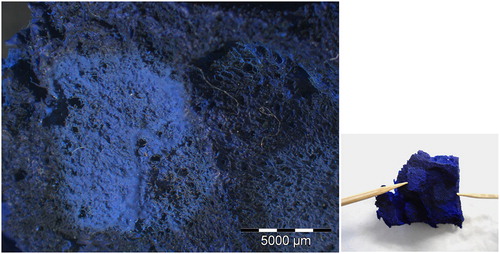
The cleaning tests carried out on glass slides did not give satisfactory results, although better than those observed on the samples made with sponges. The long duration of the pulses, associated with photothermal effects generated by the radiation, caused the heating of the binder and the incorporation of the dirt in the painted surface ().
Figure 4. SFR, loosely-adhered dirt applied on the right side of the glass slides. On the upper slide, the two spots (the first with one pulse, the second with five pulses) were obtained with Fl = 1 J/cm2, E = 350 mJ, spot = 4 mm, f = 1 Hz. On the slide below we can see a cleaned part using the same operating parameters.

LQS
The tests for the removal of the adhered dirt, both on sponges and on glass slides, carried out with a LQS laser did not produce satisfactory effects either. Instead, LQS laser applied to the non-adhered dirt on sponges gave satisfactory results with fluence values between 0.9–1.35 J/cm2, E = 250–380 mJ, spot = 6 mm, f = 5 Hz (). The experiments conducted on glass slides did not give the same good results. In this case, using the same operating parameters, we were able to remove only a part of the deposits, while the unremoved dirt was incorporated in the paint film, altering the color ().
QS
The Palladio laser (QS mode) gave positive results both on adhered and non-adhered dust deposits applied on sponges. With Fl = 0.9 J/cm2, E = 195 mJ, spot = 5.5 mm, f = 1 Hz the ablation process became evident but inconclusive because the deposits of dirt, although visibly thinned, were still strongly adhered to the substrate. With fluence values between 1.8 and 2 J/cm2, E = 270–300 mJ, spot = 4.5 mm, f = 5 Hz, most of the harder dirt could be removed, but we obtained the best result with Fl = 2.5 J/cm2, E = 300 mJ, spot = 4 mm, f = 5 Hz. In order to define a threshold risk, we increased the fluence until damage was observed, which occurred with a change in the color of the pigment at Fl = 3.2 J/cm2, E = 300 mJ, spot = 3.5 mm, f = 5 Hz.
Laser cleaning with surfaces wetted with water was also tested. We noted that we could obtain an appreciable removal of the same type of dirt working with the operating parameters that had given the best result before (Fl = 2.5 J/cm2, E = 300 mJ, spot = 4 mm, f = 5 Hz) but the typical roughness of the surface had been compromised ().
Figure 7. QS laser + water, specimen with adhered dirt. The irradiated area with Fl = 2.5 J/cm2, E = 300 mJ, spot 4 mm, f = 5 Hz. On the left, a detail after cleaning is shown.
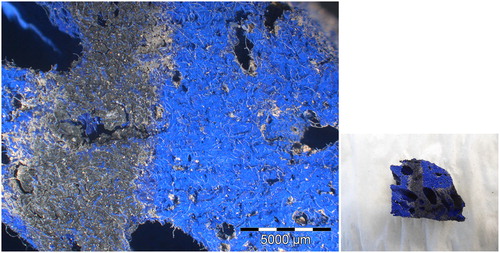
Regarding specimens covered by non-adhered dirt excellent results were obtained without altering support and paint film with Fl = 0.8–0.9 J/cm2, E = 175–195 mJ, spot = 5.5 mm, f = 5 Hz.
Using nebulized water, we reached an almost complete and homogeneous level of cleaning with Fl = 0.75 J/cm2, E = 160 mJ, spot = 5.5 mm, f = 5 Hz, although the best result was achieved with Fl = 0.8 J/cm2, E = 175 mJ, spot = 5.5 mm, f = 5 Hz, the same as the test without water. At a slightly higher fluence (0.9 J/cm2) the color changed. This operating range was too narrow and thus we decided not to use water at all.
The tests carried out with the Thunder Art laser were focused on the removal of the non-adhered dirt from sponges and glass slides, as the cleaning of the sponge in the Museum of Modern Art would be conducted with this equipment. On the sponges, we reached excellent results with Fl = 1.3–1.7 J/cm2, E = 263–329 mJ, spot = 5 mm, f = 5 Hz; deposits were completely removed, giving back the original characteristics of saturation and brightness of the color, maintaining the support perfectly intact and free of alterations (). We observed a macroscopic alteration of the paint film with Fl = 2.0 J/cm2, E = 395 mJ, spot = 5 mm, f = 5 Hz. With Fl = 2.8 J/cm2, E = 560 mJ, spot = 5 mm, f = 5 Hz a loss of the paint film occurred. The operating parameters that we found effective on the sponges were tested on glass slides, and showed a progressive cleaning effect. Furthermore, we verified that the safe operating range identified on the sponges was the same for the slides ().
Figure 8. QS Thunder Art laser applied to a, specimen with loosely-adhered dirt, using with Fl = 1.7 J/cm2, E = 329 mJ, spot 5 mm, F = 5 Hz. On the left, the detail shows that cleaning was completely successful.

Figure 9. QS Thunder Art laser applied to loosely-adhered dirt, on the right side of the slides. Slide 1: Fl = 1.2 J/cm2, E = 230 mJ, spot = 5 mm, f = 5 Hz. Slide 2: Fl = 1.7 J/cm2, E = 329 mJ, spot 5 mm, f = 5 Hz. Slide 3: Fl = 1.74 J/cm2, E = 342 mJ, spot = 5 mm, f = 5 Hz. Slide 4: Fl = 1.8 J/cm2, E = 362 mJ, spot = 5 mm, f = 5 Hz. Cleaning tests gave an increasing level of cleaning, without compromising or altering the paint film.
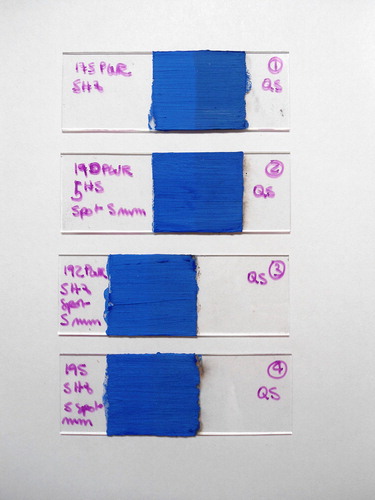
The blue sponge in the Museum of Modern Art
As mentioned, this was created using the same materials as the Sculptures-Éponge. From examination with a video microscope, we noted that some areas were not completely colored, likely because the amount of color used to soak the sponge was insufficient to ensure a homogeneous result. These anomalies probably developed during the evaporation of the solvent (). The sponge appeared to be affected by the presence of dirt deposits, both non-adhered and partially adhered to the surface; the thickness of the dirt particles was significant especially on the exposed areas, on the top of the object and on the most protruding parts ().
Figure 10. The sponge in the Museum of Modern Art before cleaning tests. Note the presence of fibers without color and of dust deposits.

Figure 11. Macro image of a portion of the sponge in the Museum of Modern Art before cleaning. Note the presence of dark particles on the surface.
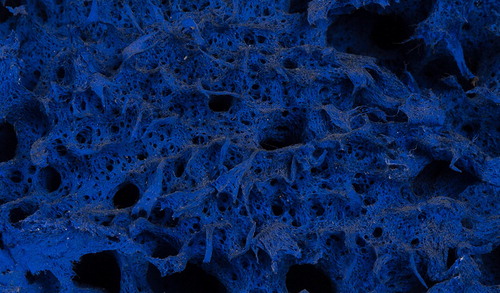
Cleaning was carried out, taking into consideration the best results obtained from the experiments conducted on the samples on which we applied the non-adhered dirt. The operating parameters identified as effective using the Thunder Art laser were Fl = 1.3–1.7 J/cm2, E = 263–329 mJ, spot = 5 mm, f = 5 Hz. We began cleaning tests on the sculpture starting from lower fluences. To define the areas for treatment and acquire to comparable data, we made paper masks with 2 cm2 windows to place on the surface during the irradiation. Since the sculpture is a three-dimensional object characterized by a significant heterogeneity of the surface, we tried to conduct tests on similar portions, so as to maintain the same distance between the laser hand piece and the sponge and to ensure uniform radiation.
The first step in the cleaning was carried out using Fl = 0.8 J/cm2, E = 157 mJ, spot = 5 mm, f = 5 Hz, but the ablative effect proved to be ineffective. The second test was carried out working with Fl = 1 J/cm2, E = 197 mJ, spot = 5 mm, f = 5 Hz; the results were positive but not entirely satisfactory, since the concretions of dirt of greater dimensions continued to cling to the substrate.
We decided to increase the frequency to 10 Hz. We obtained a complete removal of the deposits, with no alteration in either the support or the color. Therefore, the cleaning of the blue sponge was conducted with these operating parameters (Fl = 1 J/cm2, E = 197 mJ, spot = 5 mm, f = 10 Hz).
Following cleaning the object is significantly more legible: the removal of deposits from the sponge's surface allowed us to appreciate the morphological characteristics of the substrate and the chromatic properties of the paint film (A and B and ).
Conclusions
The effectiveness of lasers in the removal of dust deposits from sponges was undoubtedly positive: the long experimentation we carried out on specimens allowed us to execute successful cleaning of the blue sponge in the Museum of Modern Art.
Nd:YAG lasers, with a wavelength of 1064 nm in QS mode were used to remove dirt from the surface of Klein's sculpture. Successful laser cleaning relied on the careful optimization of cleaning parameters using a series of model samples on different substrates.
Notes
1 This article is an extract from Romina Rezza's masters thesis in ‘Conservation and restoration of cultural heritage’, entitled ‘Yves Klein's Sculptures-Éponge: degradation mechanisms, planning and execution of a conservative intervention’. University of Turin, Italy.
2 In his atelier, Yves Klein used common bath sponges, marine organisms scientifically known as Porifera (Demospongiae, Ceratospongiae order, Dittioceracidi group, named Spongiae Officinalis by Linnaeus in 1759) in this specific case composed of a skeleton-based sponging, a protein particularly rich in collagen and characterized by high elasticity.
3 The recipe for IKB:
1) IKB fixative
1.2 kg Rhodopas (solvent) MA (Rhone Poulenc) (vinyl chloride)
2.2 kg of denatured ethyl alcohol (95%)
0.6 kg of ethyl acetate
Total 4 kg.
Mix cold, with stirring.
2) Then powder of pure ultramarine blue, ref. 1311 –
is added to the fixative, mixing cold
in proportion of 50% if we add one-tenth of the total number of pure acetone
and 40% if we add pure alcohol.
Apply using a roller, a brush or a spray gun for painting.
On a wood panel, plywood
or isorel – with support brackets on the back covered with a veil.
4 Kremer Pigmente (cod. 45080, cod. 45000).
5 The artificial aging (six months, about 4,400 hours) was set on daily alternating cycles of hot-dry/wet-room temperatures using a ventilated stove set at a temperature at 40°C with a relative humidity (RH) of 30% and a humidifier giving a temperature range of 20–25°C and RH about 90–100%. The measurements of weight and size of the sponges were noted monthly. In general, all sponges lost weight and volume through the aging period, even if this was found to be most evident during the first month.
At the end of the period, all samples were placed for an other six months in an air-conditioned environment, characterized by a temperature between 20 and 23°C and a relative humidity of 50%, with the aim of observing the behaviour of the sponges in a controlled environment after the stress to which they had been subjected. Changes in temperature and humidity led to structural, macro, and microscopic variations in size and weight and were responsible for mechanical degradation which caused the detachment of micro-fragments from the samples with a pigment concentration of 50%. Despite the variations in weight and dimensions noted during monitoring, the sponge containing 40% of pigment in PVAc did not crimp (increased wrinkling on the surface).
It was therefore possible to say that in the gap between the two quantities of pigment indicated by Klein in the recipe of IKB, 40 and 50%, there is a kind of critical phase, in which the binder seems not to be able to satisfy the requirements to which it is called upon to respond. The presence of cracks, observed in the specimens made with the mixture containing 50% of pigment in the resin, is linked to the quantity of inert materials in the binder. The phenomenon of crimp, not recognizable macroscopically, may worsen culminating in the loss of microchips and pigment granules.
6 Jean Paul Ledeur made all Klein's multiples and was the restorer of many of Klein's works of art.
7 Palladio laser, produced by Quanta System SpA (Solbiate Olona, Varese). Emission source Nd:YAG, emission mode QS, pulse duration 5–6 ns, wavelength 1064 nm. Maximum energy 450 Radiation is transferred through articulated arms with seven mirrors. Profile of the beam: Gaussian.
Thunder Art laser, produced by Quanta System SpA (Solbiate Olona, Varese). Emission source Nd:YAG, emission mode QS, pulse duration 8 ns, wavelength 1064 nm. Maximum energy 1000 mJ. Radiation is transferred through articulated arms with seven mirrors. Profile of the beam: Gaussian.
EOS 1000 LQS laser produced by El. En. S.p.a. (Calenzano, Firenze). Emission source Nd:YAG, emission mode LQS, pulse duration 60–120 ns, wavelength 1064 nm. Energy 130, 250, 380 mJ. Radiation is transferred through an optical fibre.
EOS 1000 SFR laser produced by El. En. S.p.a. (Calenzano, Firenze). Emission source Nd:YAG, emission mode SFR, pulse duration 60–120 µs, wavelength 1064 nm. Maximum energy 1000 mJ. Radiation is transferred through an optical fibre.
References
- Brunetto, A. 2004. Esperienze di utilizzo della tecnologia LASER, in L'utilizzo della strumentazione LASER per la pulitura delle superfici nei manufatti artistici, Collana I Talenti, Il Prato Ed.
- Bruni, S., Cariati, F., Casadio, F., Toniolo, L. 1999. Spectrochemical characterization by micro-FTIR spectroscopy of blue pigments in different polychrome works of art, Vibrational Spectroscopy, 20: 15–25.
- Hooper, J.N.A. 2003. Sponguide. Guide to sponge collection and identification, Queensland Museum, South Brisbane, QLD, 4101, Australia.
- Laganà, A. 2009. Materiali dell'arte moderna e contemporanea, in Il LASER. Pulitura su materiali di interesse artistico: Attività sperimentale, ed. A. Giovagnoli, Kermes Quaderni, Nardini Ed.
- Ledeur, J. P. 2000. Yves Klein. Catalogue des éditions et des sculptures éditées, Guy Pieters Éditions.
- Martano, G. 1971. Yves Klein. Il mistero ostentato, ‘Nadar 6’, Martano Ed.
- Rava, A. & Brunetto A. 2007. Proceedings of the conference Aplar, Applicazioni LASER nel restauro, Vicenza 16 giugno 2007, Il Prato Ed.

